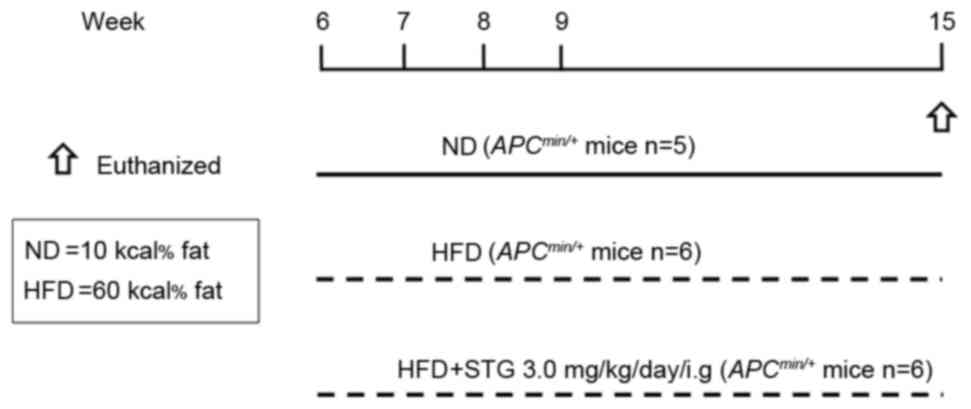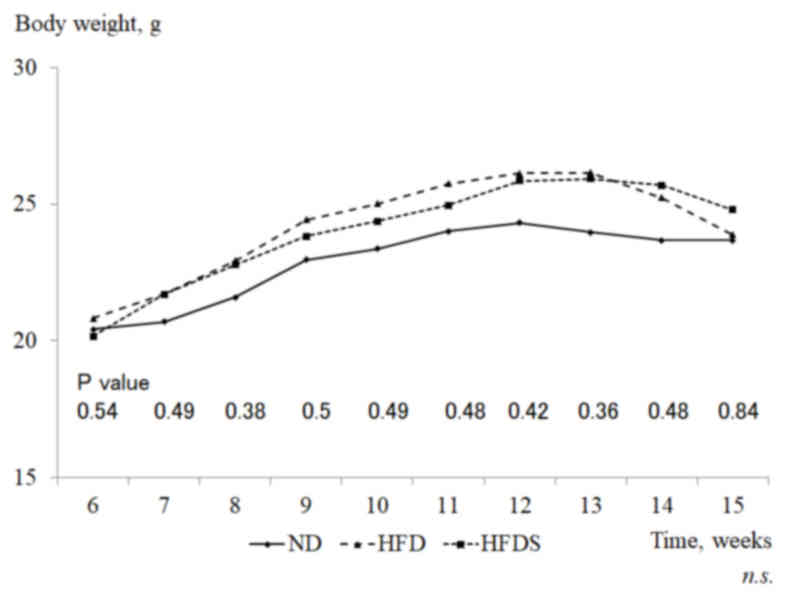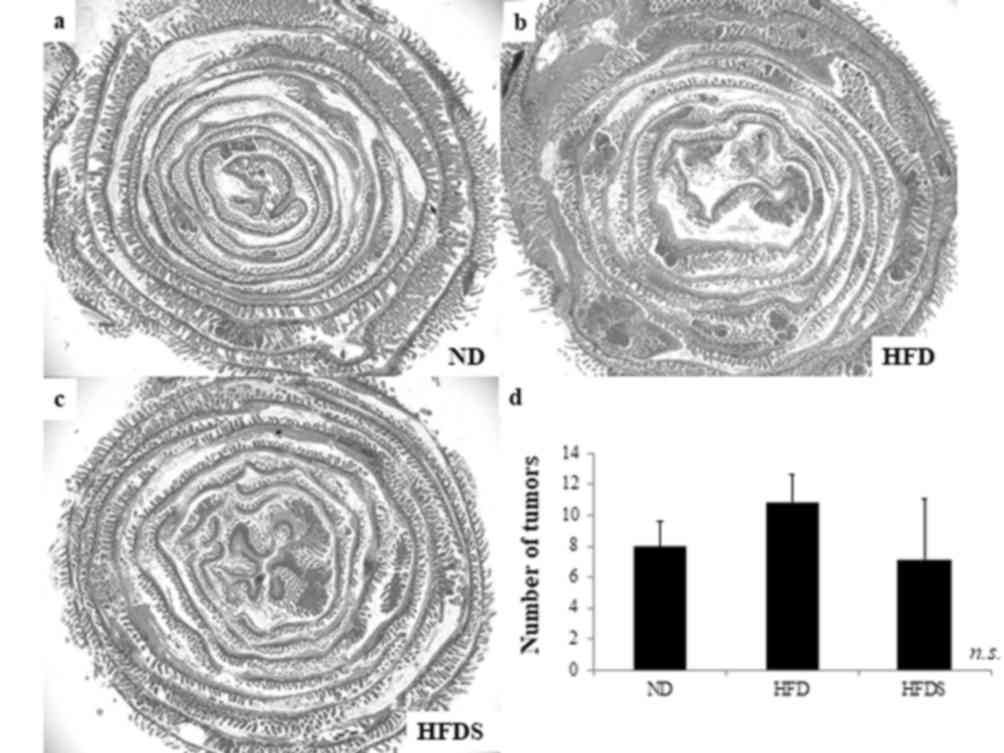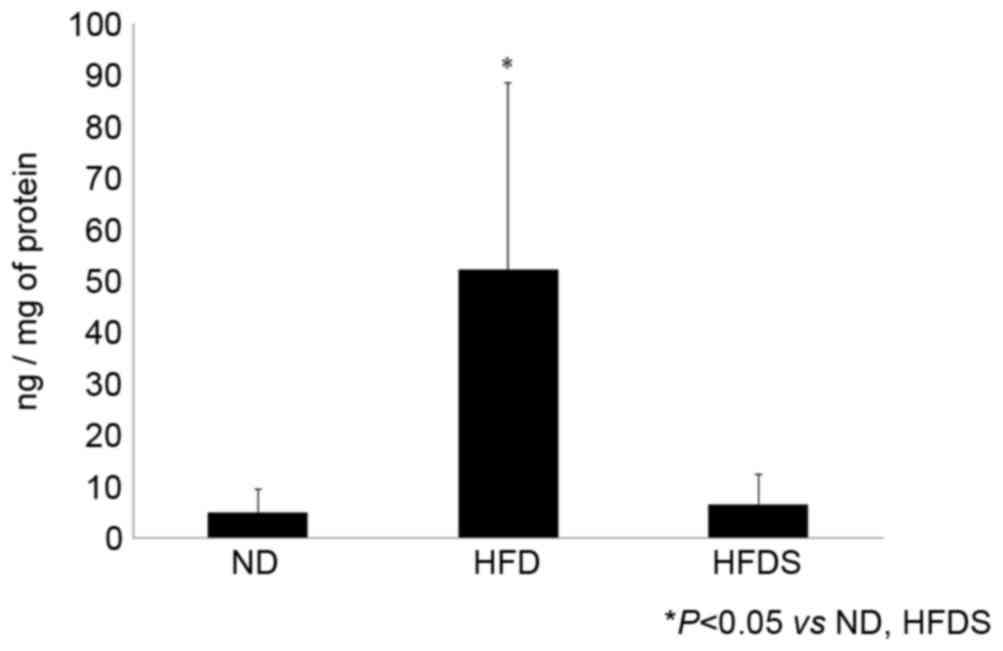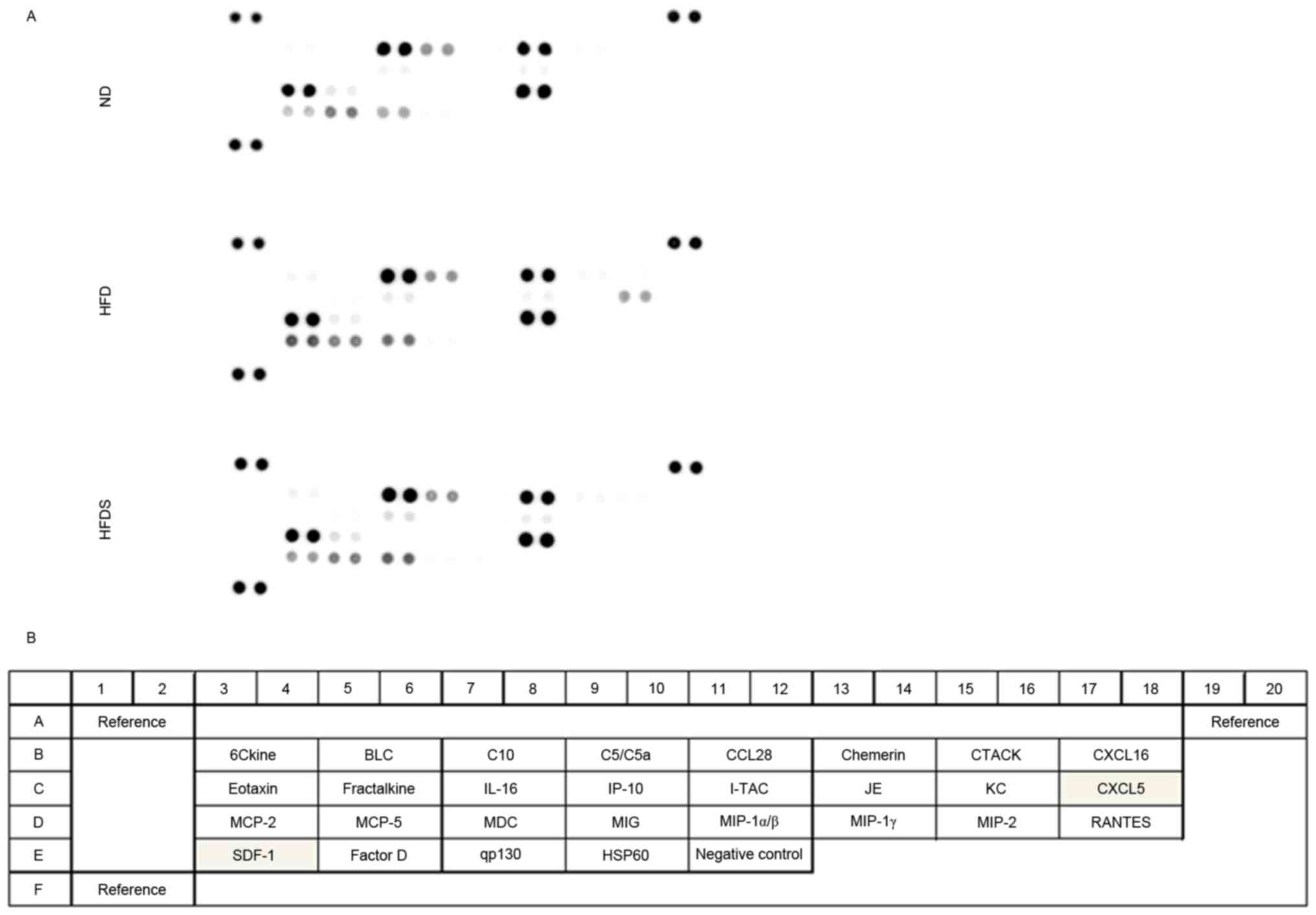Sitagliptin, a dipeptidyl peptidase-4 inhibitor, suppresses CXCL5 and SDF-1 and does not accelerate intestinal neoplasia formation in ApcMin/+ mice fed a high-fat diet
- Authors:
- Published online on: August 1, 2017 https://doi.org/10.3892/ol.2017.6698
- Pages: 4355-4360
Abstract
Introduction
Currently, the number of patients with morbid obesity is increasing in Japan, as the Japanese population has encountered a fast and radical change in their way of life, among which are dietary changes that include the consumption of a high-fat diet. It is well known that morbid obesity is associated with insulin resistance and can increase the risk for developing diabetes mellitus type 2 (1,2). Consistent with these changes, the rates of pancreatic, colon, prostate and breast cancers, which are more frequent in Western nations, have increased in Japan (2–4). The World Cancer Research Fund and American Institute for Cancer Research assessed causal associations between certain variables and each type of cancer based on systematic reviews of epidemiological evidence, and it was suggested that body fat levels exceeding recommended values markedly increases the risk of colorectal, postmenopausal breast, esophageal, endometrial, pancreatic and kidney cancers (5). Epidemiological studies have previously demonstrated that obesity increases the risk of colon cancer by 1.5–2.0-fold, with obesity-associated colon cancer accounting for 14–35% of the total incidence (6). Overall, the risk of colorectal neoplasia is increased in individuals with a body fat level that exceeds recommended values, insulin resistance and type 2 diabetes compared with individuals without metabolic disorders (7).
The gut incretin hormone glucagon-like peptide-1 (GLP-1) is secreted from enteroendocrine cells in response to ingested nutrients, and is a crucial determinant of blood glucose homeostasis due to its capacity to slow gastric emptying, increase the secretion of insulin by the pancreas, and suppress the secretion of glucagon by the pancreas (8–10). Since GLP-1 is quickly degraded and deactivated by dipeptidyl peptidase-4 (DPP-4), DPP-4 inhibitors, including sitagliptin (STG), vildagliptin and saxagliptin, have been developed as therapeutic options for the treatment of type 2 diabetes (11,12). The processing product of proglucagon GLP-2 also acts as a substrate of DPP-4. GLP-2 is a pleiotropic hormone that has an effect on numerous aspects of intestinal physiology, including epithelial development, barrier function, digestion, absorption, motility and blood flow (13,14). Potent anti-apoptotic effects are exerted by GLP-2 in the gastrointestinal tract, resulting in GLP-2 being a promising focus when investigating novel therapies for the treatment of intestinal diseases. Since DPP-4 rapidly degrades and deactivates GLP-2, DPP-4 inhibitors are viewed as a novel method for treating of intestinal inflammation (15,16). It has previously been shown that DPP-4 inhibitors have a protective effect on indomethacin-induced intestinal damage in rats (17,18). However, in terms of colon carcinogenesis, exogenous and endogenous GLP-2 has been identified as a factor that increases colon carcinogenesis in azoxymethane-treated mice (19). Furthermore, since DPP-4 also inactivates other chemokines that participate in tumor progression, including C-X-C motif chemokine ligand (CXCL) 5 and CXCL12/stromal cell-derived factor-1 (SDF-1), long-term use of a DPP-4 inhibitor may accelerate tumorigenesis in the intestine (20). However, at present, the effect of DPP-4 inhibitors on intestinal tumors has not been determined.
Materials and methods
Animals and diets
Six-week-old male C57BL/6J-ApcMin/+/J mice weighing 18–22 (Charles River Laboratories Japan, Inc., Yokohama, Japan) were used in the present study. The animals were maintained in an animal colony with controlled temperature (23°C) and light (12/12-h light-dark cycle) at the Osaka Medical College (Osaka, Japan). Mice had free access to chow pellets and tap water. The diets used in the present study were standard rodent chow (normal diet; ND) containing 10 kcal% fat and a high-fat diet (HFD) containing 60 kcal% fat (Charles River Laboratories Japan, Inc.). Ethical approval for the experiments in the present study was granted by the Animal Ethical Committee of the Osaka Medical College (Osaka, Japan) and all procedures were conducted according to the guidelines of the Institute for Laboratory Animal Research at Osaka Medical College.
Protocol for experimental procedures and tumor counts
The following three groups of mice were used in the present study: ND; HFD; and HFD + STG (HFDS). The experimental design is shown in Fig. 1. The effect of STG (0.3–3 mg/kg; intragastric gavage administration) on mucosal DPP activity was previously investigated, and it was reported that oral administration of STG dose-dependently suppressed mucosal DPP activity (17). Therefore, in the present study, the DPP-4 inhibitor STG phosphate monohydrate (3 mg/kg; Carbosynth Limited, Compton, UK) was administered to mice by oral gavage every day during the experimental period. All mice were sacrificed at 15 weeks of age. Following sacrifice, the entire small intestine from the pylorus to the ileocecal junction was excised, opened longitudinally, and rinsed with ice-cold PBS. The entire small intestine was rolled up longitudinally using a wooden stick, starting from the ileum and working toward the duodenum, with the mucosa outwardly exposed, and fixed in a 10% formalin solution. Tissue sections (4 µm) were hematoxylin and eosin stained and analyzed by K.F. and T.I., who were blinded to the treatment groups. The number, size and localization of tumors were determined.
Measurement of plasma and mucosal GLP-2, plasma CXCL5 and SDF-1
Mucosal scraped tissues were collected in lysis buffer (TBS containing protease inhibitors; Complete Mini: Roche Diagnostics, Indianapolis, IN, USA) with the DPP-4 inhibitor K-579 (Tocris Bioscience, Bristol, UK). Blood samples were collected into chilled Eppendorf tubes containing 1 µl each of 0.5 M EDTA and 100 µM K-579. The samples were immediately centrifuged at 3,000 × g for 5 min and their supernatants and plasma were kept at −80°C until measurement. Plasma and mucosal total GLP-2 was measured utilizing a GLP-2 (mouse) ELISA kit (ALPCO Diagnostics, Salem, NH, USA) according to the manufacturer's protocol. Plasma concentration of CXCL5 and SDF-1 was also determined using a Mouse LIX Quantikine ELISA kit and a Mouse CXCL12/SDF-1 alpha Quantikine ELISA kit (R&D Systems, Inc., Minneapolis, MN, USA), according to the manufacturer's protocol.
Analysis of chemokines
A Mouse Chemokine Array kit (R&D Systems, Inc.) was used to simultaneously detect the relative expression levels of 25 different chemokines. The array was performed according to the manufacturer's protocol. Blots were developed using enhanced chemiluminescence and a Fujifilm Imaging System (LAS-3000; Fujifilm, Tokyo, Japan).
Statistical analysis
All data are expressed as the mean ± standard deviation (SD). The data represent five to six animals in each treatment group. Comparisons were performed using one-way analysis of variance or Kruskal-Wallis followed by Fisher's protected least significant difference test. P<0.05 was considered to indicate a statistically significant difference.
Results
Effects of chronic administration of STG on body weight, plasma glucose level and number of small intestinal tumors
As shown in Fig. 2, mice fed the HFD had increased mean gains in body weight compared with mice fed the ND (ND, 20.5±0.4 to 24.3±1.2 g; HFD, 20.8±1.5 to 26.1±3.0 g), although the gains were not significantly different. The administration of STG did not affect the body weight in the mice fed the HFD. Mean body weights prior to euthanasia were 23.7±3.7, 23.8±3.5 and 24.8±3.2 g in the ND, HFD and HFDS groups, respectively. Plasma glucose levels measured pre-sacrifice were 264.4±51.4, 252.8±5.9 and 264.8±29.5 mg/dl in the ND, HFD and HFDS groups, respectively, and were unaffected by the administration of STG in mice fed the HFD. According to a previous study, ApcMin/+ mice developed polyps mainly in the small intestine (21). The mean number of small intestinal tumors was 8.0±1.6, 10.8±1.8 and 7.2±3.9 in the ND, HFD and HFDS groups, respectively. The administration of STG decreased the actual mean number of small intestinal tumors, although not to the point of statistical significance (P=0.086; Fig. 3).
Concentration of plasma and mucosal GLP-2
No significant difference was identified in plasma GLP-2 concentrations among the three treatment groups, whereas the concentration of mucosal GLP-2 was significantly elevated in the mice fed the HFD. In the mice fed the HFDS, the concentration of mucosal GLP-2 was significantly decreased (Fig. 4).
Analysis of chemokines
The chemokines evaluated using the chemokine array (Fig. 5) were quantified using ELISA (Fig. 6). As shown in Fig. 5, the chemokine array suggested elevated concentrations of plasma CXCL5 and SDF-1 in the HFD group, and chemokines in the HFDS group were decreased relative to those in the HFD group. Following the chemokine array, the plasma concentrations of CXCL5 and SDF-1 were determined by ELISA. These chemokines were significantly elevated in the HFD group and the long-term administration of STG significantly suppressed the plasma concentration of CXCL5 and SDF-1 (Fig. 6). This indicated that the long-term administration of STG improved metabolic status, even though the body weight and feeding plasma glucose level were not changed.
Discussion
It is well known that obesity, insulin resistance and diabetes are associated with an increased risk of colon cancer (5). Since DPP-4 inhibitors stabilize incretin hormones, in previous years they have been widely used to treat patients with type 2 diabetes mellitus. In addition, DPP-4 inhibitors stabilize hormones and cytokines, including GLP-2, SDF-1 and CXCL5, which are associated with tumor progression subsequent to long-term use (20). At present, few studies have examined the connection between DPP-4 inhibitors and colon carcinogenesis. In the present study, the concentration of mucosal GLP-2, plasma SDF-1 and plasma CXCL5 were markedly increased in mice fed a HFD compared with mice fed a ND. Notably, the long-term administration of STG significantly suppressed the concentration of those hormones and chemokines and did not increase the number of intestinal tumors in ApcMin/+ mice.
Previously, colon tumors were induced in leptin-deficient (ob/ob) mice using the colon carcinogen 1,2-dimethylhydrazine and dextran sulfate sodium (22). In this model, the long-term administration of STG significantly suppressed the mucosal expression of IL-6, which was upregulated in the colons of ob/ob mice, and significantly suppressed the number of colon tumors. Ob/ob mice are obese as they harbor a mutation that causes them to eat excessively; the administration of STG did not alter their metabolic status, including their insulin resistance. Additionally, DPP-4 is mainly expressed in the small intestine, but not in the colon, and so DPP-4 inhibitors do not affect the mucosal DPP activity in the colon (17,23). Therefore, in the previous study, the effect of a DPP-4 inhibitor on tumorigenesis in the intestines of mice could not be evaluated via assessment of the changes in mucosal DPP and GLP, even though the results provided insights about the role of a DPP-4 inhibitor (22).
CXCL5 is secreted from adipose tissue during states of obesity and mediates insulin resistance (24). CXCL5 has a well-established role in stimulating the chemotaxis of angiogenic neutrophils, particularly in response to inflammation (25). SDF-1 is also secreted from adipose tissue (26). Since SDF-1 secretion is positively associated with the body mass index in humans and induces insulin resistance, SDF-1 is considered one of the important contributing risk factors for type 2 diabetes (27). Chemokines such as these are recognized as important angiogenic factors and are reported to be associated with cancer development (28). Since they undergo N-terminal truncation by DPP-4, DPP-4 inhibition may affect tumorigenesis in the intestine via increased concentrations of CXCL5 and SDF-1. The SDF-1 concentration was reported to be increased in Dpp-4−/− mice, but whether SDF-1 is primarily regulated by DPP or not remains controversial (29,30). In the present study, the number of small intestinal tumors in mice fed a HFD to induce obesity were compared with mice fed a ND diet, and the effects with and without STG were assessed. STG suppressed the mucosal concentration of CXCL5 and SDF-1, which were significantly increased in the mice fed the HFD. Since CXCL5 and SDF-1 are substrates for DPP-4, the administration of STG is hypothesized to increase the concentrations of CXCL5 and SDF-1. However, in the present study, long-term treatment with STG in conditionally obese mice paradoxically suppressed chemokines associated with obesity. Since it has been reported that the administration of SPP-4 inhibitor improved insulin resistance and lipid metabolism (31,32), it was hypothesized that the long term administration of STG improved the metabolic status of mice fed a HFD, and as a result the expression of these chemokines was decreased.
The mucosal concentration of GLP-2 in the small intestine was significantly increased in mice fed the HFD compared with the mice fed the ND in the present study. Since luminal nutrients, including fatty acids, stimulate the production and secretion of GLP-2 in the intestinal mucosa, a HFD may contribute to intestinal tumorigenesis via increased mucosal GLP-2 (33,34). Chronic exposure to a HFD significantly increases the concentration of plasma GLP-2 and intestinal crypt-villus height (35). In the present study, similar to CXCL5 and SDF-1, mucosal GLP-2 increased in mice fed the HFD and was significantly decreased by the long-term administration of STG. These results suggest the possibility that the long-term administration of STG may be a treatment option for patients who are obese or have type 2 diabetes and are considered to have an increased risk of developing colonic polyps and cancer. However, the administration of STG generally increases the concentration of GLPs, and the mechanism of the suppressive effect of long-term STG administration on the mucosal concentration of GLP-2 in mice fed a HFD remains to be elucidated. Therefore, additional studies are required.
In conclusion, consistent with previous studies, the present preclinical study demonstrated that chronic exposure to a HFD increased the mucosal concentration of GLP-2, and the concentrations of CXCL5 and SDF-1 in the plasma. However, the long-term administration of STG in combination with HFD suppressed the expression of GLP-2 and the evaluated chemokines. Since the number of mice in the present study was small, the suppressive effect of the DPP-4 inhibitor STG on intestinal carcinogenesis was not determined. However, the long-term administration of STG did not increase intestinal tumors in mice fed a HFD. Pending clinical trials, the present results suggest that STG may be safe and suitable treatment option for patients with type 2 diabetes who are at increased risk of developing colonic polyps and cancer.
References
|
Tsugane S and Inoue M: Insulin resistance and cancer: Epidemiological evidence. Cancer Sci. 101:1073–1079. 2010. View Article : Google Scholar : PubMed/NCBI | |
|
Neville SE, Boye KS, Montgomery WS, Iwamoto K, Okamura M and Hayes RP: Diabetes in Japan: A review of disease burden and approaches to treatment. Diabetes Metab Res Rev. 25:705–716. 2009. View Article : Google Scholar : PubMed/NCBI | |
|
Siegel R, Naishadham D and Jemal A: Cancer statistics, 2013. CA Cancer J Clin. 63:11–30. 2013. View Article : Google Scholar : PubMed/NCBI | |
|
Katanoda K, Matsuda T, Matsuda A, Shibata A, Nishino Y, Fujita M, Soda M, Ioka A, Sobue T and Nishimoto H: An updated report of the trends in cancer incidence and mortality in Japan. Jpn J Clin Oncol. 43:492–507. 2013. View Article : Google Scholar : PubMed/NCBI | |
|
Vargas AJ and Thompson PA: Diet and nutrient factors in colorectal cancer risk. Nutr Clin Pract. 27:613–623. 2012. View Article : Google Scholar : PubMed/NCBI | |
|
Huang XF and Chen JZ: Obesity, the PI3K/Akt signal pathway and colon cancer. Obes Rev. 10:610–616. 2009. View Article : Google Scholar : PubMed/NCBI | |
|
Berster JM and Göke B: Type 2 diabetes mellitus as risk factor for colorectal cancer. Arch Physiol Biochem. 114:84–98. 2008. View Article : Google Scholar : PubMed/NCBI | |
|
Reimer MK, Holst JJ and Ahrén B: Long-term inhibition of dipeptidyl peptidase IV improves glucose tolerance and preserves islet function in mice. Eur J Endocrinol. 146:717–727. 2002. View Article : Google Scholar : PubMed/NCBI | |
|
Nadkarni P, Chepurny OG and Holz GG: Regulation of glucose homeostasis by GLP-1. Prog Mol Biol Transl Sci. 121:23–65. 2014. View Article : Google Scholar : PubMed/NCBI | |
|
Frezza EE, Wachtel MS and Chiriva-Internati M: The multiple faces of glucagon-like peptide-1-obesity, appetite, and stress: What is next? A review. Dig Dis Sci. 52:643–649. 2007. View Article : Google Scholar : PubMed/NCBI | |
|
Takasaki K, Takada H, Nakajima T, Ueno K, Ushiki J and Higo K: Involvement of the active metabolites in the inhibitory activity of K579 on rat plasma dipeptidyl peptidase IV. Eur J Pharmacol. 505:237–241. 2004. View Article : Google Scholar : PubMed/NCBI | |
|
Takasaki K, Nakajima T, Ueno K, Nomoto Y and Higo K: Effects of combination treatment with dipeptidyl peptidase IV inhibitor and sulfonylurea on glucose levels in rats. J Pharmacol Sci. 95:291–293. 2004. View Article : Google Scholar : PubMed/NCBI | |
|
Dubé PE and Brubaker PL: Frontiers in glucagon-like peptide-2: Multiple actions, multiple mediators. Am J Physiol Endocrinol Metab. 293:E460–E465. 2007. View Article : Google Scholar : PubMed/NCBI | |
|
Drozdowski L and Thomson AB: Intestinal hormones and growth factors: Effects on the small intestine. World J Gastroenterol. 15:385–406. 2009. View Article : Google Scholar : PubMed/NCBI | |
|
Hartmann B, Thulesen J, Kissow H, Thulesen S, Orskov C, Ropke C, Poulsen SS and Holst JJ: Dipeptidyl peptidase IV inhibition enhances the intestinotrophic effect of glucagon-like peptide-2 in rats and mice. Endocrinology. 141:4013–4020. 2000. View Article : Google Scholar : PubMed/NCBI | |
|
Boushey RP, Yusta B and Drucker DJ: Glucagon-like peptide 2 decreases mortality and reduces the severity of indomethacin-induced murine enteritis. Am J Physiol. 277:E937–E947. 1999.PubMed/NCBI | |
|
Fujiwara K, Inoue T, Yorifuji N, Iguchi M, Sakanaka T, Narabayashi K, Kakimoto K, Nouda S, Okada T, Ishida K, et al: Combined treatment with dipeptidyl peptidase 4 (DPP4) inhibitor sitagliptin and elemental diets reduced indomethacin-induced intestinal injury in rats via the increase of mucosal glucagon-like peptide-2 concentration. J Clin Biochem Nutr. 56:155–162. 2015. View Article : Google Scholar : PubMed/NCBI | |
|
Inoue T, Higashiyama M, Kaji I, Rudenkyy S, Higuchi K, Guth PH, Engel E, Kaunitz JD and Akiba Y: Dipeptidyl peptidase IV inhibition prevents the formation and promotes the healing of indomethacin-induced intestinal ulcers in rats. Dig Dis Sci. 59:1286–1295. 2014. View Article : Google Scholar : PubMed/NCBI | |
|
Iakoubov R, Lauffer LM, Trivedi S, Kim YI and Brubaker PL: Carcinogenic effects of exogenous and endogenous glucagon-like peptide-2 in azoxymethane-treated mice. Endocrinology. 150:4033–4043. 2009. View Article : Google Scholar : PubMed/NCBI | |
|
Lim JB and Chung HW: Serum ENA78/CXCL5, SDF-1/CXCL12, and their combinations as potential biomarkers for prediction of the presence and distant metastasis of primary gastric cancer. Cytokine. 73:16–22. 2015. View Article : Google Scholar : PubMed/NCBI | |
|
Johnson RL and Fleet JC: Animal models of colorectal cancer. Cancer Metastasis Rev. 32:39–61. 2013. View Article : Google Scholar : PubMed/NCBI | |
|
Yorifuji N, Inoue T, Iguchi M, Fujiwara K, Kakimoto K, Nouda S, Okada T, Kawakami K, Abe Y, Takeuchi T and Higuchi K: The dipeptidyl peptidase-4 inhibitor sitagliptin suppresses mouse colon tumorigenesis in type 2 diabetic mice. Oncol Rep. 35:676–682. 2016. View Article : Google Scholar : PubMed/NCBI | |
|
Sakanaka T, Inoue T, Yorifuji N, Iguchi M, Fujiwara K, Narabayashi K, Kakimoto K, Nouda S, Okada T, Kuramoto T, et al: The effects of a TGR5 agonist and a dipeptidyl peptidase IV inhibitor on dextran sulfate sodium-induced colitis in mice. J Gastroenterol Hepatol. 30:(Suppl 1). S60–S65. 2015. View Article : Google Scholar | |
|
Chavey C and Fajas L: CXCL5 drives obesity to diabetes, and further. Aging (Albany NY). 1:674–677. 2009. View Article : Google Scholar : PubMed/NCBI | |
|
Nunemaker CS, Chung HG, Verrilli GM, Corbin KL, Upadhye A and Sharma PR: Increased serum CXCL1 and CXCL5 are linked to obesity, hyperglycemia, and impaired islet function. J Endocrinol. 222:267–276. 2014. View Article : Google Scholar : PubMed/NCBI | |
|
Kim D, Kim J, Yoon JH, Ghim J, Yea K, Song P, Park S, Lee A, Hong CP, Jang MS, et al: CXCL12 secreted from adipose tissue recruits macrophages and induces insulin resistance in mice. Diabetologia. 57:1456–1465. 2014. View Article : Google Scholar : PubMed/NCBI | |
|
Blogowski W, Serwin K, Budkowska M, Salata D, Dolegowska B, Lokaj M, Prowans P and Starzynska T: Clinical analysis of systemic and adipose tissue levels of selected hormones/adipokines and stromal-derived factor-1. J Biol Regul Homeost Agents. 26:607–615. 2012.PubMed/NCBI | |
|
Kitahara CM, Trabert B, Katki HA, Chaturvedi AK, Kemp TJ, Pinto LA, Moore SC, Purdue MP, Wentzensen N, Hildesheim A and Shiels MS: Body mass index, physical activity, and serum markers of inflammation, immunity, and insulin resistance. Cancer Epidemiol Biomarkers Prev. 23:2840–2849. 2014. View Article : Google Scholar : PubMed/NCBI | |
|
Yazbeck R, Howarth GS and Abbott CA: Dipeptidyl peptidase inhibitors, an emerging drug class for inflammatory disease? Trends Pharmacol Sci. 30:600–607. 2009. View Article : Google Scholar : PubMed/NCBI | |
|
Busso N, Wagtmann N, Herling C, Chobaz-Péclat V, Bischof-Delaloye A, So A and Grouzmann E: Circulating CD26 is negatively associated with inflammation in human and experimental arthritis. Am J Pathol. 166:433–442. 2005. View Article : Google Scholar : PubMed/NCBI | |
|
Nakagami H, Pang Z, Shimosato T, Moritani T, Kurinami H, Koriyama H, Tenma A, Shimamura M and Morishita R: The dipeptidyl peptidase-4 inhibitor teneligliptin improved endothelial dysfunction and insulin resistance in the SHR/NDmcr-cp rat model of metabolic syndrome. Hypertens Res. 37:629–635. 2014. View Article : Google Scholar : PubMed/NCBI | |
|
Li CL, Zhao LJ, Zhou XL, Wu HX and Zhao JJ: Review on the effect of glucagon-like peptide-1 receptor agonists and dipeptidyl peptidase-4 inhibitors for the treatment of non-alcoholic fatty liver disease. J Huazhong Univ Sci Technolog Med Sci. 35:333–336. 2015. View Article : Google Scholar : PubMed/NCBI | |
|
Wang JH, Inoue T, Higashiyama M, Guth PH, Engel E, Kaunitz JD and Akiba Y: Umami receptor activation increases duodenal bicarbonate secretion via glucagon-like peptide-2 release in rats. J Pharmacol Exp Ther. 339:464–473. 2011. View Article : Google Scholar : PubMed/NCBI | |
|
Inoue T, Wang JH, Higashiyama M, Rudenkyy S, Higuchi K, Guth PH, Engel E, Kaunitz JD and Akiba Y: Dipeptidyl peptidase IV inhibition potentiates amino acid- and bile acid-induced bicarbonate secretion in rat duodenum. Am J Physiol Gastrointest Liver Physiol. 303:G810–G816. 2012. View Article : Google Scholar : PubMed/NCBI | |
|
Baldassano S, Amato A, Cappello F, Rappa F and Mulè F: Glucagon-like peptide-2 and mouse intestinal adaptation to a high-fat diet. J Endocrinol. 217:11–20. 2013. View Article : Google Scholar : PubMed/NCBI |



